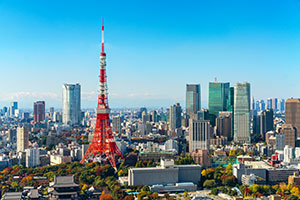Travel Answers (Formerly Travel2)
Your journey begins in Tokyo, the vibrant capital of Japan. Pulsating with energy and innovation, Tokyo manages to seamlessly blend tradition with modernity. Towering skyscrapers coexist with historic temples, creating a captivating skyline. The city's efficient transportation system interconnects its diverse neighborhoods, each with its own distinct character, from the bustling streets of Shibuya to the serene gardens of Shinjuku Gyoen. Tokyo is a culinary paradise, offering a myriad of flavors from Michelin-starred restaurant fare to street food, satisfying every palate.
Changing the pace, travel by bullet train to Shizuoka, a multi-faceted gem hidden in plain sight. Here you will have many opportunities to spy majestic but elusive Mt Fuji, as well as to learn how green tea is grown and visit Miho no Matsubara, a coastal spot which is known to be one of the most beautiful views in all Japan.
From Shizuoka, take the bullet train to Kyoto. Nestled amidst picturesque mountains, Kyoto is a treasure trove of cultural heritage, boasting over 2,000 temples and shrines, including the iconic Fushimi Inari Taisha and the majestic Kinkaku-ji. Stroll through its charming streets lined with traditional wooden machiya houses and immerse yourself in the serene beauty of its meticulously landscaped gardens. Kyoto's tea houses and Gion geisha district offer glimpses into Japan's rich traditions. In spring, cherry blossoms blanket the city, while autumn paints it in fiery hues, making Kyoto an enchanting destination year-round.
Next, bullet and local trains take you to Kurashiki, a captivating blend of old-world charm and modern allure. Its well-preserved Bikan district, with its beautifully preserved Edo-period buildings lining the picturesque Kurashiki River, evokes a sense of nostalgia and tranquility. Wandering through its cobblestone streets, visitors encounter quaint shops, galleries, and museums, such as the Ohara Museum of Art, showcasing both Western and Japanese masterpieces. The city's traditional Kurashiki Bikan kurabu boats offer a leisurely cruise along the waterway, providing unique views of the historic district.
Finally, travel to Hiroshima, a city etched in history, rising as a symbol of resilience and peace. Despite its tragic past, Hiroshima has emerged as a beacon of hope, advocating for nuclear disarmament and promoting reconciliation. The Peace Memorial Park and Museum poignantly honor the victims of the atomic bombing. Amidst this solemnity, Hiroshima flourishes as a vibrant metropolis, boasting modern architecture, bustling shopping streets, and delectable cuisine like okonomiyaki. Its picturesque landscapes, including the tranquil Hiroshima Peace Memorial Park and the scenic Miyajima Island, offer solace and serenity.
Vacation Inclusions
- Private airport transfers
- Inter-city travel on bullet and local trains
- 11 nights 5-star accommodation
- Breakfast daily
- Full day private Traditional Tokyo tour
- Half day private Shizuoka Fuji tour
- Full day private Kyoto temples tour
- Full day private Nara tour
- Full day private Hiroshima & Miyajima tour
Featured Destinations
Hiroshima
Hiroshima
Hiroshima in southwestern Honshu has grown rapidly as a commercial city, and after 1868 it was developed as a military base. Every August 6 since 1947, thousands participate in multidenominational services in the Peace Memorial Park built on the site where the bomb exploded. After the war the city was largely rebuilt, and commercial activity gradually resumed. Visit the Peace Park but also explore Miyajima Island and its colourful shrines and mysterious forests.
|
Destination Guide
|
Kurashiki
Kurashiki
Kurashiki means the “warehouse village.” During the feudal era, the warehouses were used to store rice from the surrounding area. Many of the warehouses have now been converted into museums. Explore the traditional architecture and beautiful canals of this picturesque city. White-walled houses with traditional black tile roofs line the streets, while mansions with lattice windows and weeping willows along the canal complete the peaceful picture of a Japanese town as it existed centuries ago.
|
|
|
Shizuoka
|
|
Tokyo
Tokyo
Tokyo, Japan, presents a different view at every turn. It's one of the world's main economic centers and its most populous agglomeration. The business of Tokyo is business, but you can still find harmony and small-scale gardens on back streets. Around the corner from neon and concrete, you may find the bonsai-lined courtyard of a traditional inn. Tokyo was nearly destroyed by bombs and fires during World War II, and by earthquakes at other times, but it has always rebuilt itself. As a result, there is little left of Old Japan in the city, but there's plenty of New Japan to take its place. The streets are a confusing maze, so a map is essential. The transit system is excellent, however, and there are kobans (police boxes) throughout the metropolis, as well as a populace generally willing to answer questions. Visitors to Tokyo represent both business and leisure travelers. And despite its past reputation, Tokyo is no longer fearsomely expensive. It's relatively easy to visit Tokyo on a budget.
|
Destination Guide
|
Kyoto
Kyoto
If you can visit only one city in Japan, Kyoto is the one. This ancient city, 30 mi/50 km northeast of Osaka, was the capital of Japan for more than 1,000 years and still is considered the country's spiritual capital. Thousands of shrines and temples dot the city, including more than a dozen on the UNESCO World Heritage list. That list is far from all-inclusive, and many excellent places that might be the star attractions of other cities crowd the streets of Kyoto. It is a center of Japanese Zen and has several huge monastery complexes where serious students still sit in meditation. Kyoto is also the nation's capital of traditional arts. Whether your interest be in pottery, textiles, dance, the tea ceremony or any of the other innumerable arts, Kyoto has excellent galleries, museums, shops and tea houses. Japanese people from the countryside and foreign students flock there to learn under the great masters. Much of what is considered Japanese haute cuisine was developed there too, as an offshoot of the tea ceremony. Kyoto is Japan's heartland of history. With 1,300 years of tumultuous existence, the city's past intrudes upon the present day as in few other Japanese cities. In Gion, you can spot a geisha (or geiko, as they are called in Kyoto), one of the last hundred or so in Japan, slipping down a side-street to entertain rich guests with witty conversation, dance or music. A shopping arcade may suddenly fill with discordant clanging music as a shrine festival passes among the shoppers, or you may hear the long chant as Zen monks pass through the neighborhood, calling for alms. Kyoto is an understated city that might disappoint visitors at first (at first glance, it is a large city with modern buildings that might not align with one's original perception); its charm lies in small details, pocket gardens, tiny traditional restaurants and refined artwork.
|
Destination Guide
|
Osaka
Osaka
This large, bustling port is the starting point for tours to the ancient cities of Kyoto and Nara, the cultural fountainheads of classical Japan. Kyoto's Old Imperial Palace and the shogunal Nijo Castle remain glorious symbols of the power the city held for over 1,000 years. Until 1868, Kyoto was the capital of Japan, filled with elegant timber buildings and, perhaps more than any other Japanese city, imbued with Kami, the divine spirit. You'll sense it everywhere, for there are hundreds of Shinto shrines and over a thousand Buddhist temples, as well as sacred treasure-houses of religious sculpture, painting and exquisite gardens. Nara, City of the Seven Great Temples, lies in an idyllic setting.
|
Destination Guide
|
View Full Itinerary
Valid Date Ranges






